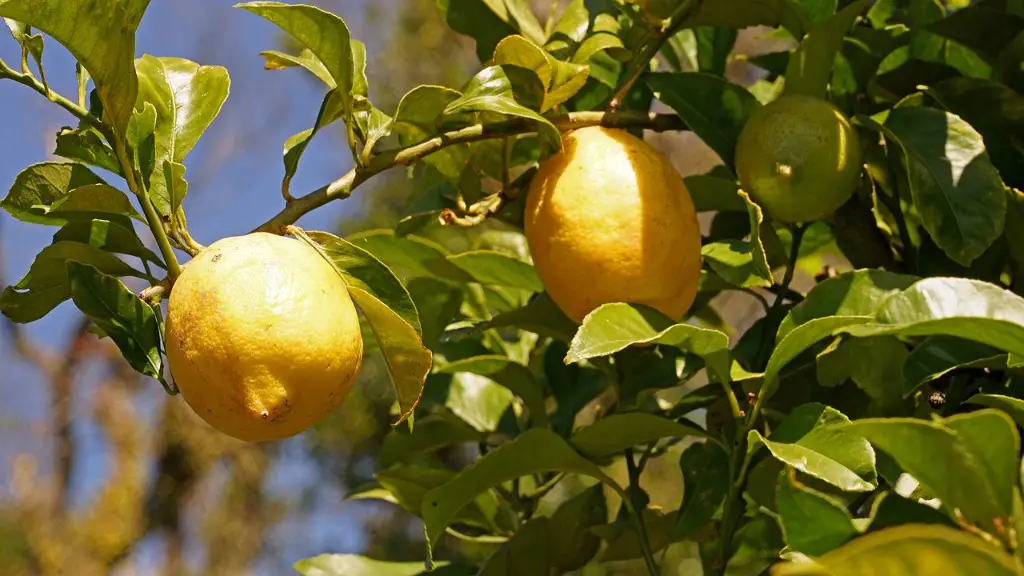Bringing your lemon tree indoors is a great way to extend its growing season for some extra flavor and fruits. However, there are some things to consider before bringing your lemon tree inside. Depending on the type of tree you have, it might not do as well indoors as it did outside. Here’s when to bring your lemon tree indoors.
First, you need to consider the temperature. Ensure that the room you are bringing it into is above 10°C (50°F). Temperature fluctuations below this range can cause citrus tree damage. If you are in an area with a warm climate, you can bring your lemon tree indoors all year round.
Second, you should consider the amount of light available. For citrus trees to thrive, they need between 8-12 hours of direct sunlight per day. If the environment you are bringing it into does not get this amount of light, you should consider supplementing it with artificial lighting or a grow light.
Thirdly, you should look at the amount of humidity the room has. To keep lemon trees thriving they need a humidity level of between 50-65%, a level that is not often matched indoors. If your lemon tree is indoors in a dry climate, you should consider using a humidifier.
Fourthly, you should consider the amount of space available. Lemons trees require plenty of space for their roots to grow, so you should make sure you are bringing it into a space that can accommodate it. If the area is too small, it may not cause harm but it won’t be able to grow to its full potential.
Fifth, examine the soil your lemon tree is planted in. When bringing your tree indoors, you want to ensure that the soil is free from pests and disease. If your soil does not meet these standards, you should consider repotting your tree in new soil or treating it for any potential issues.
Finally, inspect your tree for any signs of pests. If you notice any, you should take steps to get rid of them before bringing your tree indoors. Lemons trees are especially prone to being attacked by pests such as spider mites, aphids and mealybugs.
What Kind Of Lemon Tree Should I Bring Indoors?
When deciding which lemon tree to bring indoors, you should consider the type of tree and the climate you live in. If your climate can support it, you should opt for a tree with a more traditional growing cycle such as a Meyer Lemon Tree or a Lisbon Lemon Tree. Both of these varieties flourish in both indoor and outdoor climates.
If you live in a colder climate, you should opt for a more resilient lemon tree such as a Key Lime Tree or a Kumquat Tree. These trees can withstand lower temperatures and low light conditions better than its traditional counterparts.
No matter which type of lemon tree you decide to bring indoors, make sure that the environment you are bringing it into is conducive to its needs. This will ensure that your tree is able to thrive and produce its succulent fruits year round.
How Do I Care For My Indoor Lemon Tree?
Caring for an indoor lemon tree requires more attention than one that is outside. As the tree is not exposed to as much natural sunlight, you may have to supplement it with a grow light or an artificial light. Additionally, you will have to keep a close eye on the humidity levels to make sure it’s not too dry.
Fertilizing the tree is another important factor to consider. As the tree is not exposed to as many natural elements, it may require additional nutrients to keep it healthy. To make sure your tree is getting all the nutrients it needs, you should fertilize it at least twice a year.
Pruning is also important for an indoor lemon tree. This will help give the tree a denser structure and ensure it gets enough airflow. Prune lightly, just removing any deadwood or branches that are too close together. This will also encourage new growth.
Finally, make sure your indoor lemon tree gets the necessary amount of water. Monitor the soil constantly and water when it is dry to a depth of 2 inches. If the soil is too moist, the tree could become susceptible to a variety of diseases.
How Do I Protect My Lemon Tree From Pests & Disease?
Protecting your lemon tree from pests and disease is an important part of ensuring it is healthy and safe. The first line of defense is to monitor your tree closely for signs of pests or disease. If you do notice pests, take steps to get rid of them quickly.
You can also use insecticidal soap or Neem oil to help protect your tree. Both of these remedies can be applied directly to the leaves and bark of the tree, offering protection from a variety of pests. Always spray the tree in the early evening so that the oil can stay on the tree all night.
It is also important to make sure the tree is getting all the nutrients it needs. Fertilizing the tree regularly and making sure the soil is well drained will help ensure the tree is getting the necessary nutrients and air circulation.
Finally, make sure to prune your tree regularly. This will help give it a denser structure and ensure that it is getting enough air circulation. This also prevents diseases like citrus canker and green mold, which can be fatal to citrus trees.
How Should I Bring My Lemon Tree Indoors?
Bringing a lemon tree indoors is a delicate process, so it is important that you take all the necessary precautions. First, make sure the room you are bringing it into is at an ample temperature and has the necessary amount of light and humidity.
You should also take the necessary steps to ensure the soil is pest and disease-free. If it is not, repot the tree into a new potting soil or treat the disease. When you are ready to bring it inside, be sure to handle it gently and move it slowly.
Once you have brought the tree inside, check to make sure it is in a spot that is both far away from drafts and gets the necessary amount of light. You should also make sure that the tree is away from any sources of heat or cold, as both can cause damage to the tree.
Finally, be sure to check your tree regularly for signs of pests or disease. Inspect it for any wilted, yellowing or browning leaves. If you notice any, take the necessary steps to get rid of them and protect your lemon tree from further damage.
What Are The Benefits Of Bringing My Lemon Tree Indoors?
Bringing your lemon tree indoors allows you to make use of the space to grow a variety of different fruits. It also allows you to extend the growing season of your tree, so that you can enjoy its tasty fruits throughout the year.
In addition, your tree will be able to benefit from the additional light, humidity and temperature stability indoors, allowing it to reach its full potential. Finally, the tree will benefit from being treated as an indoor plant. Regular monitoring, pruning and fertilizing will help keep your lemon tree healthy and strong.
Having a lemon tree indoors is a great way to enjoy the convenience of plenty of delicious fruit without having to worry about the temperamental climate outdoors. With the proper care and a balanced environment, you will be able to enjoy your tree’s amazing aroma and flavors all year round.





